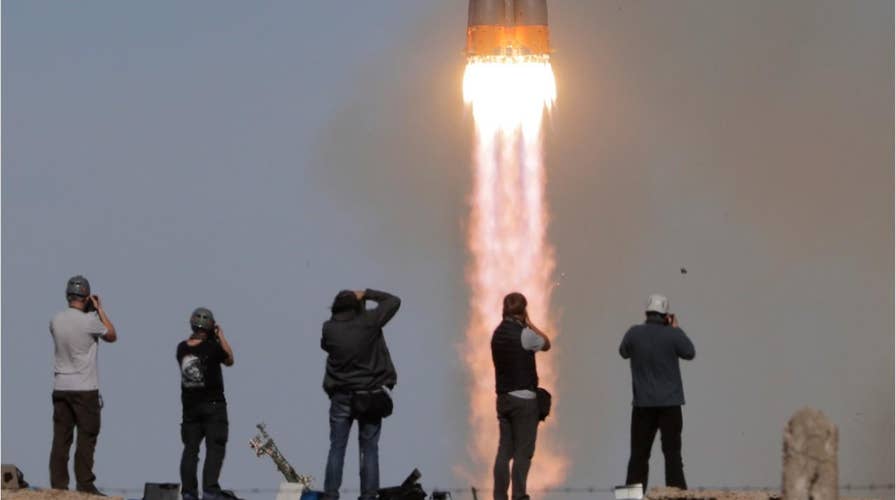US, Russia space crew aborts mission after booster failure
A US-Russia mission to the International Space Station hit a snag on Thursday when a Russian Soyuz rocket carrying NASA astronaut Nick Hague and Russian cosmonaut Alexey Ovchinin malfunctioned during its ascent and the two-person crew made an emergency landing.
A Russian space investigation has blamed a damaged sensor for forcing a Soyuz rocket to abort its trip just two minutes after it was launched.
NASA astronaut Nick Hague and Russian cosmonaut Alexei Ovchinin made a dramatic escape shortly after the Oct. 11 launch from the Baikonur Cosmodrome in Kazakhstan.
The spacecraft was about 30 miles above Earth’s surface when the crew was forced to make a dangerous “ballistic re-entry” into Earth’s atmosphere. After the successful deployment of its parachute, the rescue capsule landed safely in the steppes of Kazakhstan about 30 minutes after the rocket failure.
US, RUSSIAN ASTRONAUTS MAKE DANGEROUS BALLISTIC RE-ENTRY INTO EARTH’S ATMOSPHERE AFTER ROCKET FAILS
Oleg Skorobogatov, who led the probe into the accident, told reporters Thursday that the investigation found that the sensor was damaged during the final assembly at the launch pad in Kazakhstan.
Russian rockets are manufactured in Russia and then transported by rail to the Russia-leased Baikonur cosmodrome.
Skorobogatov said officials are now taking steps, including putting all assembly staff through competence tests and additional training, to make sure such malfunctions don't happen again.
SOYUZ ROCKET FAILURE: BOOSTER SEPARATION WAS TO BLAME FOR BOTCHED LAUNCH, RUSSIA SAYS
The rocket producer will also take apart two other rockets that have been recently assembled and are due to launch in the coming weeks and then re-assemble them, Skorobogatov added.
Last month, Russia said that the launch went awry after one of the rocket's four boosters failed to jettison about two minutes into the flight, The failure damaged the main stage and triggered the emergency landing, according to Russian space agency Roscosmos.
Nonetheless, the aborted mission dealt another blow to the troubled Russian space program that currently serves as the only way to deliver astronauts to the orbiting outpost.
NASA ASTRONAUT DESCRIBES DRAMATIC ESCAPE FROM FAILED SOYUZ ROCKET
The Russian program has been dogged by a string of problems with unmanned launches in recent years. Space.com notes that Russia lost a $45 million weather satellite last year as a result of a programming error. The satellite went into the wrong orbit when the wrong coordinates were used, according to The Guardian.
In 2011, an eagerly-anticipated Russian probe to Mars was lost when it failed to follow its intended course. A year earlier, a rocket carrying three communications satellites fell into the Pacific Ocean.
However, the recent incident was the first manned failure for Russia since September 1983, when an earlier version of Soyuz exploded on the launch pad. In that incident, a Launch Escape System saved the two crewmembers.
'THERE WAS A BIT OF TENSION': ASTRONAUT DESCRIBES WATCHING MOON LANDING WITH BUZZ ALDRIN’S FAMILY
The country’s space program has been in the spotlight. Russia recently described a hole found on the International Space Station as likely an act of sabotage. NASA has denied this and the two space agencies are working to find the cause of the problem.
Since the retirement of the space shuttle in 2011, the U.S. has been relying on Russian Soyuz rockets, launched from the Baikonur Cosmodrome, to get astronauts to the Space Station. NASA pays up to $82 million per Soyuz seat to the orbiting space lab.
Roscosmos officials on Wednesday met with their counterparts from NASA to give them a full briefing on the malfunction, Roscosmos director general Dmitry Rogozin said Thursday.
NASA’S HISTORIC APOLLO 7 MISSION SPLASHED DOWN 50 YEARS AGO TODAY
Russian space officials plan to conduct two other unmanned Soyuz launches before launching a crew to the space station.
The U.S. space agency is planning to launch manned missions from American soil in the coming years. The space agency recently announced the nine astronauts that will crew the test flights and first missions of the SpaceX Crew Dragon and Boeing CST-100 Starliner spacecraft.
The Associated Press contributed to this article. Follow James Rogers on Twitter @jamesjrogers









































